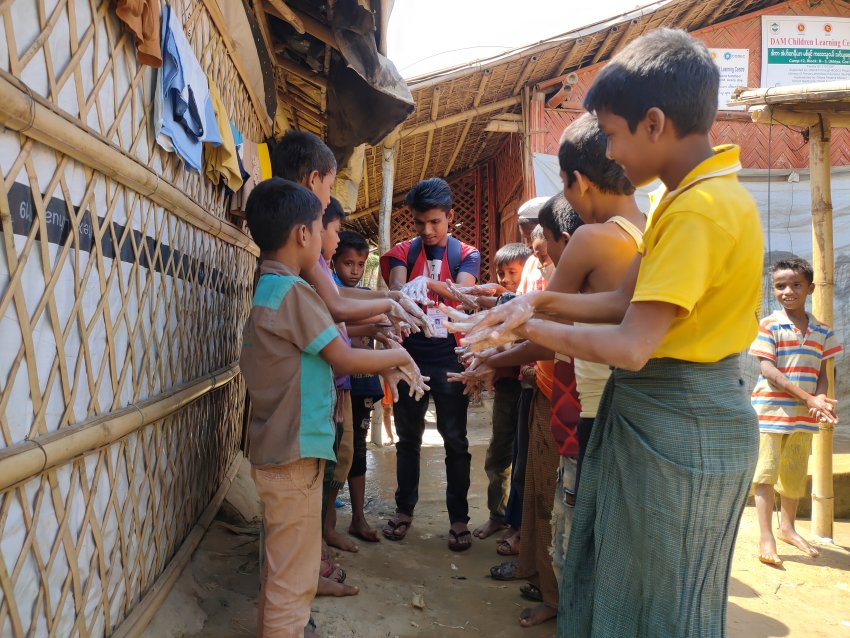
To date, there have been no cases of COVID-19 amongst the close to a million Rohingya refugees currently sheltering at camps in southern Bangladesh. However, in the Cox’s Bazar region — where the largest camp, Kutupalong, is situated — there have been confirmed virus cases.
Right now, the refugees are in lockdown. The majority of the mainly Muslim population fled to Bangladesh following the August 2017 military crackdown in their homeland — Myanmar’s Rakhine state. The Rohingyas were fleeing widespread slaughter, the burning of villages and mass rape.
A Rohingya refugee cuts his son's hair during the lockdown. Photo Ro Yassin Abdumonab - Copy.jpg

The UNHCR (the United Nations refugee agency) has warned that, with a population density in these camps greater than New York City, the Rohingya refugees “are considered to be among the most at risk globally in this pandemic”.
And on top of all this, the monsoon is about to wreak its annual havoc.
Distancing in displacement
I met Ro Yassin Abdumonab on the side of the road at Kutupalong last November. Besides acting as a guide for journalists, the freelance translator and photographer is also a local resident, having fled the genocide being perpetrated in his hometown of Maungdaw.
“I was forced to leave my motherland because I am a Rohingya Muslim. I am an Indigenous citizen of my country, but today I am denied my right to live peacefully,” he explains. “Now, I am surviving at the world’s largest refugee camp. And still struggling to get back my rights.”
A mullah searches the internet for COVID information at a high point. Photo Ro Yassin Abdumonab.jpg

Abdumonab has lately been running a COVID-19 awareness campaign at the camp. The 27-year-old has been educating refugees on the importance of washing hands, social distancing, wearing masks and staying at home, which at Kutupalong is a makeshift shelter made of bamboo and tarpaulin.
“My people have been following these rules to prevent this virus,” Abdumonab told Green Left. “But for refugees it is very hard to maintain social distance, because one million refugees are taking shelter in a small space.”
Yassin teaches the importance of social distancing. Photo Ro Yassin Abdumonab.jpg

When I first met Abdumonab, he took me to a lookout and pointed to the last banyan tree standing above the camp, which was forest not so long ago.
On April 30, he was with UNHCR staff at a newly constructed bamboo isolation ward, which can hold up to 50 patients in the case of a COVID-19 outbreak.
Rohinhya led organizations are invited by @IOMBangladesh @MSF KTP to check the preparation of isolation ward implemented by MSf The're 50 isolation beds now for patients who be infected by Covid-19 More beds will prepared by all actor@MIJamjoom @KaamilAhmed @LouiseDonovan16 pic.twitter.com/RdJa8xPAoR
— Ro Yassin Abdumonab (@Muhamma29985123) April 30, 2020
A waiting game
Abdumonab said the Bangladeshi government has been supplying soap, hand sanitiser and cleaning products. However, he adds that the lockdown is difficult, with households of often six to seven family members holed up in one-room shelters under tarpaulin.
Basic necessities and services are getting scarcer at the camps, as there are greater restrictions on who can enter. Up to 80% of aid workers previously present are now barred. The relocation of those living in high-risk monsoon areas has been halted due to the lockdown.
Rohinhyas watch COVID-19 related news during lockdown. Photo Ro Yassin Abdumonab.jpg

“The fears are that so many of my people still don't know about this disease and there’s also a blackout on communication and no internet at the camp,” Abdumonab said. “So, it’s difficult for people to get enough information about this.”
“Countless refugees will die soon if the disease does break out.”
[Ro Yassin Abdumonab is a freelance photographer based at the Kutupalong refugee camp in Cox’s Bazar. Paul Gregoire is a Sydney-based journalist and writer for Sydney Criminal Lawyers]